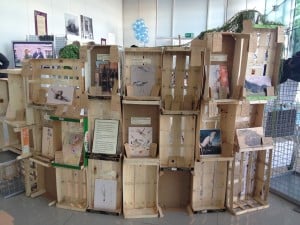Review: Samantha Williams on Ruskin Re-Viewed at Sheffield’s Millennium gallery
November 22, 2015

When my partner decided on Sheffield as the place he wanted to do his MSc I was dubious. I had never stopped off in the city and the only picture I had was a great grey cloud of smoke billowing out of Tinsley Towers as we sped past on the M1 when I was a child. Yet, when I started looking into the arts scene and the various different cultural engagement programmes I was not only pleasantly surprised but also hungry, I wanted to see this not-so-celebrated cultural hub of the north, and I wanted to see it now!
So, last weekend I grabbed my first chance at a full free day and set off on an adventure to see what Sheffield has to offer the world of art. I decided to start off with the Millennium Gallery’s section of the current ‘Going Public’ exhibition which highlights four European art collections. However, being new to the gallery layout and not yet fully awake it was the museum’s retrospective of a recent community engagement programme (Ruskin in Sheffield), appropriately entitled Ruskin Re-viewed that I stumbled into first.
Surprisingly, up until this point I had not come across the work of renowned art-philanthropist John Ruskin (1819-1900). Falling somewhere between the over-bearing importance placed on the ability to replicate ‘old masters’ during my high school education and the almost exclusive focus on contemporary art throughout my degree, I seem to have missed the reach of Ruskin all-together.
 For those of you, like myself, who are unfamiliar with his work, Ruskin – acclaimed as being ‘the best art critic this country has ever produced’ (Philip Hoare 2014), was an achieved writer, artist, critic, architect and social activist (amongst many other things) from the Victorian period. In recent years his notoriety has increased due to the release of films Mr Turner, which gives an interpretation of Ruskin’s relationship to acclaimed British painter J.M.W Turner, and Effie Gray, which discusses the nature of Ruskin’s marriage. Both were released in 2014 and neither portray Ruskin in a particularly favourable light.
For those of you, like myself, who are unfamiliar with his work, Ruskin – acclaimed as being ‘the best art critic this country has ever produced’ (Philip Hoare 2014), was an achieved writer, artist, critic, architect and social activist (amongst many other things) from the Victorian period. In recent years his notoriety has increased due to the release of films Mr Turner, which gives an interpretation of Ruskin’s relationship to acclaimed British painter J.M.W Turner, and Effie Gray, which discusses the nature of Ruskin’s marriage. Both were released in 2014 and neither portray Ruskin in a particularly favourable light.
Conversely to this, the Ruskin in Sheffield programme seeks to explore the lasting effects of Ruskin’s work as a philanthropist, significantly his founding of The Guild of St George, which according to their website, was established by Ruskin ‘to right some of the social wrongs of the day and make England a happier place in which to live’. Today, the Guild describes itself as a charitable education trust, which aims to pursue Ruskin’s philosophies towards education and community in contemporary ways.
On arriving at the Ruskin Re-viewed exhibition, it took me a moment to digest exactly what it was that I was looking at. The space was decorated densely with photographs, artefacts, drawings and text, all displayed exuberantly throughout. From photographs of a Ruskin trail through Walkley, displayed poetry and painting from interactive workshops, text from a talk about the idea ‘What is Wealth?’, all the way through to the produce of a workshop that encouraged communities to grow their own vegetables – the programme organisers had certainly been busy!

Ruskin Exhibition
Admittedly, upon realising that the exhibition was a retrospective, I was sorely disappointed. Being a firm conspirer with the attitudes of Kate Genever and Steve Poole in their text work ‘Art is not doing enough. So what will we do about it?’ (which was pointedly on display in the Museums Ruskin collection that is on loan from the Guild of St George), I hate having missed an opportunity to see art being used to perpetuate social growth and education through interaction. This disappointment was short-lived however, as I moved deeper into the exhibition it became very obvious that the organisers had placed a significant importance on the ongoing interaction of the exhibition’s audience. Each section gave the opportunity for you to add your own insight in to Ruskin, the areas he affected such as Walkley, or even just add an idea that you thought ‘could make lives more beautiful, peaceful and fruitful in Sheffield?’ alongside images of the Peak district and illustrations by Ruskin.
This piece in particular highlighted to me the positive effect of interactive art. As I stood between a small boy and an elderly lady, all three of us delighted with the concept of being able to open a jar and see what was inside! A very simple mechanism for the discussion and extension of positivity and community, delivered in such an inviting way. The most significant part of the exhibition as a whole was the ‘buzz’–people were talking, they were interacting, both with the art and with each other.
On returning home that evening I started using the information I had gathered that day to research the work of Ruskin and his reach into the contemporary world, and I have to say, I was shocked at the extent of work the man did in his lifetime and how far his reach still carries. Every time I do an internet search for something Ruskin related I get a dozen more ways in which his work is creating opportunities for community growth today.
So, while the Ruskin in Sheffield programme is over and the retrospective has now finished, you can still see the permanent Ruskin Collection at the Millennium gallery, and they have another Ruskin-inspired exhibition opening in January 2016, or you can go on the Guild of St George’s website for an up-to-date list of Ruskin related events.




Comments